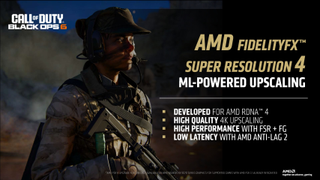- AMD announces FSR 4’s exclusivity to RDNA 4 Radeon RX 9070 series GPUs
- It’s unclear why the RX 9060 won’t have FSR 4
- Team Red’s main rival Nvidia has made DLSS 4 backwards compatible
There were hardly any doubts over AMD conceding ground to Nvidia at CES 2025, with the unveiling of new GPUs on both sides overshadowed by AMD’s recent shift to a focus on mid-range options, but Team Red has also confirmed that FSR 4 will be exclusive to the new RDNA 4 GPUs - and I’ll be honest, that sucks.
As noted by VideoCardz, FSR 4 will only be available to Radeon RX 9070 series GPU owners, including games that already have FSR 3.1 support, such as Call of Duty: Black Ops 6. This is in stark contrast to FSR 3, which is available for all AMD users and beyond thanks to its open-source design, serving as a huge benefit for handheld gaming PCs as well.
Now, FSR 4's technology is said to be 'developed for RDNA 4' (the hardware microarchitecture of the new Radeon GPUs) which could be the main reason for this exclusivity. Despite this, it isn't exactly clear yet why the upscaling method is being omitted from other hardware, especially after Nvidia's announcement of DLSS 4 being available for all existing RTX GPUs - a step in the right direction for Nvidia on this occasion.

Should we be worried about AMD's position in the GPU market?
In previous articles, I’ve made my frustrations clear regarding Nvidia’s decision to make DLSS 3 and Frame Generation exclusively available for RTX 4000 series GPU owners. Team Green has now made amends with DLSS 4, which will be available for all RTX GPUs except for the Frame Generation feature, which remains exclusive to the RTX 4000 and the recently revealed RTX 5000 series (with the new-and-improved ‘Multi Frame Generation’ only on RTX 50 series).
This brings me to AMD’s decision to focus on mid-range GPUs this generation, which was a concern, to say the least - but after hearing that FSR 4 will only be available to RX 9070 series GPUs, I honestly believe Team Red could be in big trouble.
Even with a fresh focus on the midrange space, the lack of backward compatibility will hurt AMD’s gamer-friendly image - especially with Nvidia’s claim of the RTX 5070 performance being equal to the RTX 4090’s (most likely while using Multi Frame Generation and DLSS 4), priced at $549 / £539 / AU$1,109. Pricing on AMD’s new cards has yet to be revealed, but if it can’t undercut Nvidia’s new midrange champion, Team Red could be in dire straits.
If AMD’s RX 9060 doesn’t have access to FSR 4 (which at the very least is implied in the FSR 4 slide pictured above), the RTX 5070 will be a much easier choice at an affordable price. While FSR 4 could prove to be a massive leap over the previous rendition, it’s hard to see this beating Nvidia’s offerings unless the new Radeon GPUs are cheaper than the new Blackwell GPUs.



/cdn.vox-cdn.com/uploads/chorus_asset/file/25833258/Screenshot_2025_01_15_at_8.11.01_PM.png)






 English (US) ·
English (US) ·